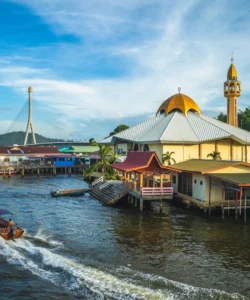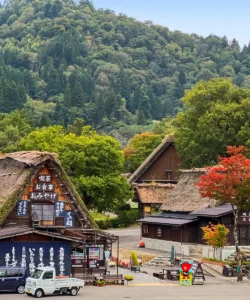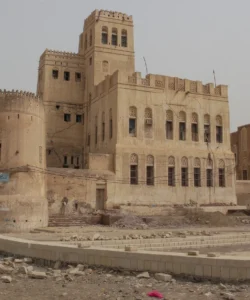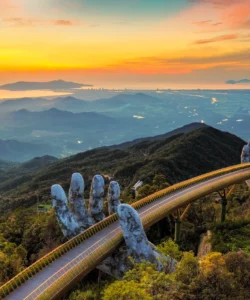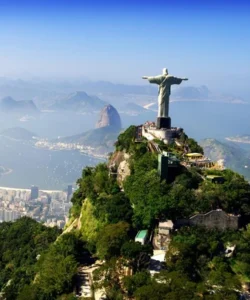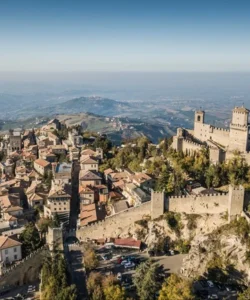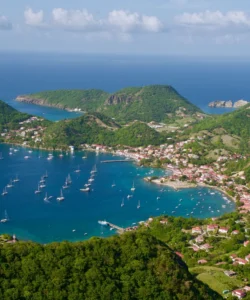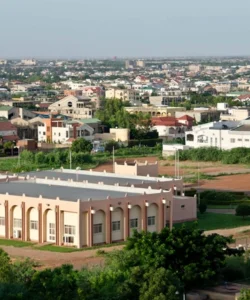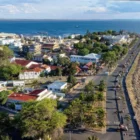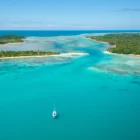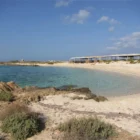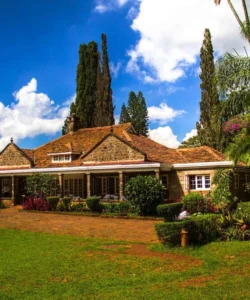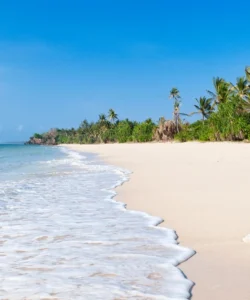The Perhentian Islands, whose name means “stopping point” in Malay, are a pair of idyllic tropical islands located off the northeastern coast of Peninsular Malaysia. Known for their crystal-clear turquoise waters, pristine white-sand beaches, and abundant marine life, they offer a laid-back paradise for travelers seeking a balance of relaxation and aquatic adventure.
Listen to an introduction about Perhentian Islands

Name: Perhentian Islands (Pulau Perhentian, consisting of Pulau Perhentian Besar – Big Island, and Pulau Perhentian Kecil – Small Island)
Address: The Perhentian Islands are situated in the South China Sea, approximately 21 kilometers (13 miles) off the coast of Terengganu, Malaysia. The main departure point for boats to the islands is Kuala Besut Jetty.
How to Get There:
Getting to the Perhentian Islands requires a boat transfer, adding to their secluded charm:
- To Kuala Besut Jetty (Mainland):
- By Air: The most efficient way is to fly from Kuala Lumpur (KLIA or Subang Airport) to Sultan Ismail Petra Airport (KBR) in Kota Bharu, Kelantan. The flight takes about an hour. From Kota Bharu Airport, you’ll need to take a taxi or Grab (about 1 hour) to Kuala Besut Jetty. Alternatively, you can fly to Kuala Terengganu Airport (TGG), which is further, requiring about a 1.5-hour taxi ride to Kuala Besut.
- By Bus: Overnight buses are a popular and budget-friendly option from Kuala Lumpur (Terminal Bersepadu Selatan – TBS), Penang, or other major Malaysian cities directly to Kuala Besut. The journey can take 7-10 hours. It’s recommended to take a night bus to arrive in Kuala Besut in the morning, ready for the first boat.
- By Car: You can drive to Kuala Besut (around 6-7 hours from Kuala Lumpur) and park your car at one of the secure parking lots near the jetty for a daily fee.
- From Kuala Besut Jetty to Perhentian Islands:
- Public Speedboat: This is the most common option. Boats operate daily from 8 AM to 5 PM (weather permitting). The ride takes about 30-45 minutes. You’ll purchase a return ticket, which typically costs around MYR 70. The boat will drop you off directly at the beach near your chosen accommodation, as there are no jetties on most parts of the islands. Expect to wade through shallow water to get on and off the boat.
- Private Speedboat: More expensive but offers flexibility in departure times and direct transfers to your beach.
- Marine Park Conservation Fee: A marine park conservation fee (currently RM30 for foreigners) must be paid at Kuala Besut Jetty before boarding the boat.
Landscape and Architecture:
The Perhentian Islands are characterized by their pristine natural beauty and a deliberately understated, low-impact architectural style.
- Two Main Islands:
- Pulau Perhentian Besar (Big Island): Generally caters to families, couples, and those seeking a quieter, more relaxed atmosphere. It has slightly more upscale (though still relatively simple) resorts and is known for its beautiful, less crowded beaches.
- Pulau Perhentian Kecil (Small Island): Popular with backpackers, solo travelers, and those looking for a more social and budget-friendly vibe. Long Beach on Kecil is known for its lively atmosphere, beach bars, and fire shows.
- Pristine Beaches: Both islands boast stunning white-sand beaches fringed with swaying palm trees, leading into incredibly crystal-clear turquoise waters.
- Lush Jungle Interior: The interior of both islands is covered in dense, untamed tropical rainforest, offering opportunities for jungle trekking and exploration. You might encounter monitor lizards, monkeys, and various bird species.
- Coral Reefs and Marine Life: The islands are part of a National Marine Park, protecting the vibrant coral reefs that surround them. These reefs are teeming with diverse marine life, including colorful fish, reef sharks (harmless blacktip reef sharks), sea turtles, and various rays.
- Lack of Roads and Motorized Transport: A defining feature of the Perhentian Islands is the absence of roads and land vehicles. Movement between beaches and resorts is primarily by water taxi (small boats) or by walking along designated jungle trails. This contributes significantly to the islands’ peaceful and untouched atmosphere.
- Simple, Eco-Friendly Accommodation: The “architecture” on the islands is largely in the form of simple beach chalets, wooden bungalows, and resort-style accommodation, often built with natural materials like wood and thatch. There are no high-rise hotels or large international chains, preserving the islands’ natural charm. Many establishments are designed to be rustic and blend into the environment.
What Makes It Famous:
- Snorkeling and Diving Paradise: The Perhentian Islands are globally renowned for their exceptional snorkeling and diving opportunities. The clear waters, healthy coral reefs, and abundant marine life (including frequent sightings of turtles, sharks, and various fish) make it a top destination for underwater enthusiasts. It’s also known as one of the cheapest places in the world to get a PADI diving certification.
- Pristine Beaches and Turquoise Water: Their picture-postcard beaches with soft white sand and dazzlingly clear, calm waters are a major draw for relaxation and swimming.
- Laid-Back, Unspoiled Vibe: Unlike some more developed island destinations, the Perhentians maintain a relaxed, unhurried atmosphere due to the lack of roads and large-scale development. It’s a place to disconnect and immerse in nature.
- Two-Island Character: The distinct personalities of Perhentian Besar (quieter, family-oriented) and Perhentian Kecil (livelier, backpacker-friendly) allow visitors to choose an experience that best suits their travel style.
- Turtle Conservation: The islands are important nesting grounds for sea turtles, and there are often opportunities to participate in or learn about turtle conservation efforts, especially between June and September.
- Jungle Trekking: Beyond the beaches, the lush interior offers rewarding jungle treks between bays, providing a different perspective of the islands’ natural beauty.
- Affordability: Compared to some other famous island destinations in Southeast Asia, the Perhentian Islands generally offer a more affordable tropical getaway, particularly on Perhentian Kecil.
Differences from Some Other Wonders:
- Primary Focus on Marine Activities & Beaches: While other Malaysian wonders might be famous for mountains (Mount Kinabalu), rainforests (Taman Negara), or modern architecture (Petronas Twin Towers), the Perhentian Islands’ fame is almost exclusively tied to its world-class marine environment (snorkeling, diving) and pristine beaches. The land-based activities, while present, are secondary.
- Lack of Roads/Motorized Land Transport: A significant differentiator is the absence of roads and cars. This creates a unique tranquil environment and dictates that all movement between bays is by foot (jungle trails) or water taxi. This contrasts sharply with most other wonders that are accessible by road.
- Seasonal Accessibility: Unlike year-round destinations, the Perhentian Islands are heavily impacted by the northeast monsoon season (roughly November to March), during which most resorts and businesses close due to rough seas and heavy rain. This seasonal operation is a key characteristic.
- Budget to Mid-Range Focus: While there are some mid-range resorts, the islands historically catered more to backpackers and budget travelers, and while prices have increased, it’s still generally more affordable and less “luxury resort-centric” than some other famous island destinations (e.g., The Maldives).
- “Twin Island” Distinction: The clear division into two main islands with different vibes (Big and Small) that cater to distinct traveler demographics is a unique feature compared to single-island destinations.
- No Large-Scale Man-Made Structures: Unlike the man-made marvels like the Langkawi Sky Bridge or Maguga Dam, the Perhentian Islands’ appeal is almost entirely rooted in their natural, relatively untouched beauty, with minimal large-scale architectural interventions.

























